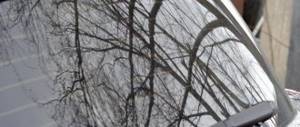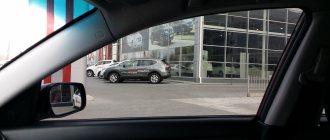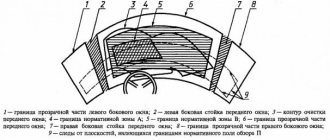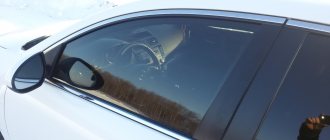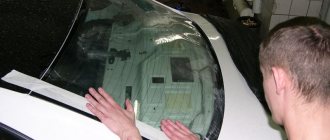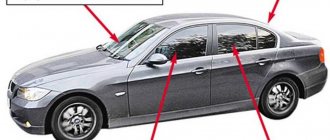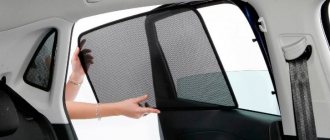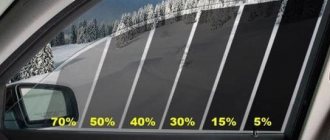Table of contents
- What tint is allowed?
- Acceptable glass tinting according to GOST
- Windshield tinting rules
- Acceptable tinting of the side windows of the first row
- Car rear window tinting
- Rules for tinting rear side windows
- Checking the car tint level
- The nuances of tinting car windows
- Fines for illegal tinting
- Conclusion
One of the simplest and most common methods of tuning is still tinting. You just need to do it correctly; the car windows must be tinted strictly in accordance with GOST. Otherwise, you may run into a fine. Let's look at what nuances are present here.
What tint is allowed?
Now tinting is regulated according to GOST 33997-2016. This document came into force this year. More precisely, this GOST has been in effect for several years, only the traffic rules contained footnotes to an outdated document: GOST 5727-88.
In general, the differences between the old and new document regarding tinting are minor. It’s just that Russian traffic rules have been brought into line with the technical regulations of the Customs Union.
According to GOST, the following types are allowed.
- Glass tinting with a film whose light transmission complies with GOST.
- Applying a colored stripe to the top of the windshield.
The use of mirror tinting, as well as the use of film with a green tint, is prohibited.
How to tint a car without breaking the law
Tinting in our country is not only a remedy against obsessive attention or heat, but also protection against damage to plastic, which loses its saturation under the scorching sun, and the inquisitive glances of potential thieves.
Athermal film
The first way to stay within the rules and cover your car with tint is to use athermal film. How is it beneficial for glass?
- Light transmittance.
- Possibility of heat removal.
- Good visibility is maintained when driving at night and in adverse weather conditions - be it heavy rain or fog.
- There is no specular effect, and the tint is greenish.
The second method is to apply a sticker to the top of the windshield. Its permissible width is prescribed by GOST 5727-88. Often this figure does not exceed 15 centimeters, but here you need to take into account the boundaries of regulatory zones, the operation of windshield wipers, and the driver’s viewing angle in all kinds of situations. The third method is to use glass with electrochrome - the most expensive of the three options. This glass allows the driver to change the level of light transmission. But we must take into account the fact that this is not legal.
Who to entrust the process of tinting car windows
Glass tinting is carried out by official services that have the appropriate license for this. Also, branded service stations have films in accordance with the established sample. And people involved in tinting have the necessary experience and skills. Such services are required to issue a certificate that confirms the quality and takes into account the light transmittance of the film. This document can be presented to the traffic inspector if his device suddenly shows data different from the documented ones.
How to tint
Tinting is done exclusively from the outside by gluing it to the glass. You need to tint glass using the following tools:
- scissors or knife;
- soap solution;
- rubber spatula;
- dry, clean cloth;
- a hair dryer that has power potential.
Acceptable glass tinting according to GOST
If you decide to tint your car windows, you need to consider that each glass has its own requirements. A sufficient amount of light must pass through the tinting, otherwise you will receive a fine, and driving a car where the glass limits visibility is unsafe.
The level of tint depends on what glass it is applied to. In general, the legislation has now been significantly simplified, with the exception of the windshield; it must be covered with a tint that ensures the passage of at least 70% of light rays. If light does not pass through it efficiently, problems may arise during testing.
A general requirement for all glasses is that they should not distort the correct perception of white, yellow, red, green and blue colors. That is, no color tinting.
After the introduction of new requirements, many motorists believed that the current GOST standardizes only the light transmission of the windshield. In fact, this is a misconception. Let's look at what requirements are currently relevant for different types of glass on a car.
Windshield tinting rules
The requirements for a car windshield are the most stringent. Let's list the main points.
- Minimum light transmission - 70%.
- Mirror and color tinting is prohibited.
- The color stripe must be of a strictly defined thickness.
Let's look at these points in more detail, first of all, comparing them with the previous requirements.
The new GOST implies a light transmission of 70%, previously it was 75%. It turns out that the windshield can be tinted more strongly using a darker film. Although in practice you probably won’t even notice a 5% difference.
There should not be any mirror film on the windshield. This is a gross violation for which the inspector will fine you even without measuring the level of light transmission. The same can be said about color films. No yellow or green glass should be used.
A narrow colored stripe may be used on top of the windshield. The width of the strip should not exceed 140 mm, and should not be in the area of effect of the windshield wipers. Wipers cleaning the windshield should not enter the lane.
Regarding the stripe, it is worth adding that sometimes you can get a fine for it. The fact is that GOST imposes the same requirements on it as on the rest of the glass, that is, the level of light transmission must be at least 70%. This means the strip should be transparent.
Also, there cannot be any inscriptions or extraneous stickers on the windshield. The inscription on the colored stripe is also a violation. Usually, road inspectors do not pay attention to the inscription on the lane, but if they want to get to the bottom of it, they can issue a fine. They have a right. Just keep this in mind.
If there is a violation of the windshield tinting, the inspector may not only fine you, but also prohibit further movement, citing safety requirements.
When is a traffic police inspector’s verdict about non-compliance of tinting illegal?
Traffic police officers often take advantage of the car driver’s ignorance of most of the listed provisions of the law. Having made sure that the driver “floats” in the regulatory framework, traffic police officers sometimes grossly violate his rights, believing that because of a fine of 500 rubles, only a few will appeal the illegal decision.
The most common illegal arguments of traffic police officers regarding tinting:
- Obvious minimum light transmission without proper tint measurement. No “Why measure it, you can’t see anything!” not allowed. Even if a perfectly black film is visible to the eye, its non-compliance with the Regulations must be confirmed with a special device. However, in practice, the traffic police inspector will issue a fine under Part 1 of Article 12.5 of the Code of Administrative Offenses, allegedly for objects that limit visibility - and here he does not need to prove light transmittance.
- Indication that it is inadmissible to use removable tinting without measuring light transmission. The argument that this is a change in the design of the car is unfounded, and a violation of the rules for operating the car must also be confirmed by the results of an inspection with a special device.
Most often, traffic police officers use such methods of influence on the driver in cases where:
- tinting “by eye” without measuring is on the verge between compliance with standards and their violation;
- the traffic police has difficulties checking glass with a special device (for example, it is faulty or has problems with documents/certificates);
- there is a corrupt interest in resolving the issue outside the legal framework.
What are the consequences of violation, besides a fine?
In any of the above cases, insist on your own. But, if you are sure that the tinting violates the provisions of the Regulations and the Code of Administrative Offenses of the Russian Federation, voluntarily remove the tinting at the request of the traffic police. In order to avoid being held accountable for disobeying a lawful order of a police officer. What it is?
This is a common practice today to write out demands to stop the conditions leading to the violation. We discussed this issue in more detail in a special article about the requirement for tinting.
Something else useful for you:
- Is it possible and how to drive tinted without getting fines and arrest?
- Is it legal to tint taillights?
- Is athermal tinting prohibited according to GOST and what is the fine?
Acceptable tinting of the side windows of the first row
There is no direct mention in the regulations of regulating the level of light transmission that front windows must have. This caused drivers to erroneously think that they could even be tinted completely. Unfortunately, this is an incorrect statement.
The rules and regulations mention that glass should not interfere with normal visibility from the driver’s seat. If you tint the glass tightly, your view will be obstructed. It turns out that completely “blind” window tinting is prohibited.
When checking, inspectors are guided by the standard for the windshield. It turns out that tinting with a light transmission of at least 70% is allowed. If you are given a fine for this violation, it will be extremely difficult to challenge it. The inspector will refer to the limitation of visibility, and according to current legislation he will be right.
Therefore, to avoid troubles, it is better not to heavily tint the side windows. Make sure there is enough light coming through the car's front door windows.
Also, mirror tinting is completely prohibited here. A car with such tuning risks the owner being fined. A ban on further movement is not imposed if a police officer tries to detain the car, this is a violation on his part.
Current responsibility today
As of May 26, 2021, the current traffic police fine for tinted windows is 500 rubles under Part 3.1 of Article 12.5 of the Code of Administrative Offenses of the Russian Federation. But in practice, you may be faced with a removal order with the prospect of being arrested for up to 15 days and even having your registration revoked for this. Below we will look at these additional penalties in detail.
Please note that, unlike most other liability standards in administrative sanctions, there is no alternative to a fine in the form of a warning. Part 3.1 of this article only provides for the issuance of a decision with a fine by the traffic police.
There are no repeated fines in 2021 for tinting, nor is there any deprivation of rights.
Expert opinion
Dmitry Tikovenko
Automotive law expert. 7 years of experience. Areas of specialization: civil law, disputes over compulsory motor liability insurance and road accidents
It is worth remembering that, in addition to a fine, you will most likely also be required to eliminate the offense. This means that you will have to remove the tint. And depending on the region in which the administrative offense is committed, they may require removal either right on the spot, or be given a certain period of time.
For failure to comply with this requirement, the driver will face liability under Article 19.3 of the Administrative Code, up to and including arrest for 15 days.
Ask a Question
For the front “hemisphere”
By the way, it is the front hemisphere that is prohibited for excessive darkness. Please note that tinting as such is not prohibited in principle - you have the right to apply film to glass, as well as spray darkening compounds on them and otherwise reduce the amount of light they transmit. The fine is issued precisely because of the “wrong” tint.
However, the limit of such reduction is clearly defined - 70% of all light emitted by any light sources must pass through your tint. This is what the Technical Regulations prescribe. And the Code of Administrative Offenses, when introducing a fine, refers precisely to this normative act.
The technical regulations in its paragraph 4.3 of Appendix No. 8 indicate forward visibility. But who, in fact, said that we are talking specifically about the front hemisphere: the windshield and front side windows of the car? This state of affairs is dictated by GOST 33988-2016 in paragraph 2.14, which literally says the following:
Forward Visibility: Visibility through the front and side windows of the cab, limited to a driver's field of vision of 180o. In the horizontal plane when the line of sight from the driver’s seat is directed parallel to the median longitudinal plane of the vehicle.
An example of blind tinting in a circle with light transmittance below 70%
Behind the rear windows
But the rear windows of a car are allowed to be tinted at least 100%, and there should be no fine for this by law. But only under one important condition - your car has both external side mirrors (there may not be an internal one in the cabin - for example, pickup trucks and utility vehicles).
This is prescribed by the same paragraph 4.3 of the regulations.
Is there a difference between managing by day or by night?
No. The illegality of tinting with light transmission below the required value is not determined by the time of day. And the measuring device itself emits light, so its readings also do not depend on whether it is night or day.
You will also be interested in:
- New traffic police fines and changes to traffic rules from March 1 and 20 - true or false?
- Changes in traffic police fines from January 1: new law and table of current fines
- New traffic regulations: The traffic police have prepared amendments and fines - is this true or not? When do they take effect?
Is there a discount?
Yes. You can pay the above fine for tinting of 500 rubles at a discount. But here, too, there is a condition - no more than 20 days must pass from the date of the decision with punishment. In this case, you have the legal right to pay a fine for the film in the amount of 250 rubles.
What kind of requirement?
This is an additional measure of responsibility that is now often issued to the driver along with a fine... Illegal, by the way.
As you now know, the current fine for tinting in 2021 is 500 rubles, and with a discount it is even 250. This amount of sanction is perceived by many car owners who are fans of tinting as an indulgence - that is, simply a payment for the opportunity to break the law. And then the inspectors came up with a trick. They began to demand to “eliminate the conditions that give rise to the offense.” Yes, and it’s not so hot to demand, but in writing, to show the driver the seriousness of this administrative procedure. Particularly stubborn employees began to call this an order.
And now the main thing. Failure to comply with a legal requirement of a traffic police officer is punishable by a minimum penalty of a fine of 500 rubles, and a maximum penalty of attention, administrative arrest for up to 15 days, under Part 1 of Article 19.3 of the Code of Administrative Offenses of the Russian Federation.
Do they give a real prison term for tinting? Judicial practice on this measure of restraint, however, differs between regions and cities. Thus, most often the requirement is applied in Moscow and Tatarstan.
We discussed the legality of such a requirement in one of the previous articles. In short, it is illegal, therefore the arrest is illegal. However, this does not prevent even judges from supporting the practice of “serving time” for such a “gross” violation as tinting. Here is a striking example from one of our site’s readers about such a prescription.
What else is cancellation of registration?
Things are even more complicated here. But most importantly, recently and until 2021, this is also not entirely legal. Let us explain what's going on here.
- The requirement for light transmission of front windows to be 70% is contained in the Technical Regulations. This legal act regulates the design components of vehicles, including those in use. Therefore, tinting that transmits less than 70 percent of the light source is a design change. And this should only happen if you have permission from the traffic police (clause 7.18 of the Basic Provisions of the Traffic Regulations).
- Previously, the relevant Order contained a condition that if changes are made to the design without such permission, then such a car is not subject to registration, and an already registered car is subject to termination of this very registration.
- But on January 1, 2021, the Federal Law on Registration was introduced, as well as in pursuance of its Decree of the Government of the Russian Federation No. 1764, and these documents contain slightly different wording, which essentially does not allow cars to be forcibly deregistered when changing the design.
- Thus, paragraph 59 of PPRF No. 1764 indicates that, by decision of the chief inspector of the traffic police for the district, the car is subject to termination of registration on the basis of paragraph 6 of part 1 of article 18 of the Federal Law on registration.
- In turn, this paragraph refers to Part 1 of Article 20 of the same law, which states that interference with a car is prohibited if the design does not comply with the documents that identify the vehicle.
- In our case, the documents do not and cannot indicate anywhere (neither in the PTS nor in the registration certificate) the presence of tinting with a certain light transmittance. Therefore, cancellation of registration is also illegal.
And again, alas and ah, but in practice in 2021 this may not help you - after a fine for tinting is issued, you may receive a letter about the termination of registration with a requirement to present the car for inspection with the tinting removed.
Car rear window tinting
Here again we look at the guest bill and pay attention to the lack of mention of the rear window tinting features. But, as with the front side windows, there are nuances here. Let's take a closer look at them.
- The rear window can only be tinted if there are external mirrors. Otherwise, at least 70% of the light rays must again pass through it.
- The use of mirror films is prohibited.
In general, most passenger cars can have full rear window tinting without problems. But, if for some reason you do not have side mirrors, you can get a fine at least one.
Checking the car tint level
Inspectors use special equipment to perform the inspection. Moreover, the device must be certified and fully comply with GOST. Employees undergo additional training before admission.
If you are stopped on the road to check the level of light transmission, the inspector must have a certificate for the device, as well as a document confirming its admission to measurement.
It is also worth paying attention to where you were stopped. By law, car glass inspections can only be carried out at a stationary traffic police station. Although there is an exception. If a special operation or raid is taking place, they can stop you anywhere to check the technical condition of the car.
In this case, traffic police officers must also have an order to conduct a special event. If there is none, but the inspectors insist on taking measurements, it is better to agree so as not to receive another report for “obstructing legal actions.” But you shouldn’t sign a protocol on the violation; you should write that you do not agree with the inspector’s decision. Later you will appeal this decision in court.
The regulatory documents do not indicate how the light transmittance of glass should be measured. Therefore, the inspector does this without witnesses. There's nothing wrong with that. If you do not agree with the received parameters, ask the employee to take the measurement again.
Also, GOST does not indicate what weather and ambient temperature should be when taking measurements. This is logical, the car should be safe in any weather without any assumptions. So measurements can be made both in the cold and during a rainstorm.
It is important to monitor the actions of the employee so that he does not place film or other object blocking the light rays between the sensors of the device.
You can try to determine the level of light transmission yourself. The result will be approximate, but will already give you a rough idea of the risk of getting a fine. To do this, you need to know the light transmittance of the film and the glass itself. It should be understood that they are summed up, reinforcing each other.
The calculation is simple, multiply the coefficients and divide the result by 100. The result is the light transmission level as a percentage. Let’s say our windshield transmits 90% of light, and the film transmits 70%, we consider that it worked out.
75*90/100 = 67,5%
As you can see, we got 67.5%, which means a meeting with an inspector will lead to a fine.
The nuances of tinting car windows
In practice, it is not enough to look only at light transmittance; there are also some nuances in tinting that drivers forget. But, they can lead to a fine.
The first is the use of tint film. In fact, by sealing the glass, we make changes to the technical characteristics of the vehicle. And this is fraught with a fine. Are you surprised? No, let’s try to tell you why experts think so.
Each glass in a car has its own characteristics, primarily to ensure safety in case of an accident. For example, the front glass does not break into fragments, or rather breaks, but the impact must be very strong for this to happen. But the glass of the front doors, on the contrary, crumbles into small crumbs, and this crumb does not have sharp edges.
By gluing the film we change the technical and physical parameters of the glass. For example, the side glass no longer shatters upon impact, which does not comply with GOST. It might even become traumatic. It is generally unknown how glass tinted with film will behave in an accident. Accordingly, we made an unsafe change to the technical characteristics of the vehicle.
In practice, inspectors on the road do not bother with such tinting. But the presence of statements about the unsafety of this method of tinting suggests that sooner or later this standard will be introduced.
You cannot use film that has a greenish tint. It is equivalent to a mirror image, which means it is prohibited. If you can use color films of other colors on the rear windows, it is better not to use mirror films with a green tint.
Be careful with the inscriptions. There should be no writing on the windshield. If you change your windshield, do not buy one with the inscription on it. If you can remove the film with the inscription right in front of the inspector, although you will have to tinker, then you won’t be able to pick out the inscription from the triplex, you will have to leave on a tow truck. Or even pick up the car from the impound lot.
If you buy already tinted glass, not only look at the certificates, be sure to ask the seller to check the level of light transmission with you.
Valid values
GOST 5727-88 prescribes the following:
- the windshield of the car must transmit light at least 75 percent;
- front door glass - more than 70 percent.
At the same time, GOST does not regulate the tinting of other car windows in any way, so they can be tinted with a film of any light transmittance. However, it is said that tinted glass should not spoil the driver’s perception of red, yellow, white, green, as well as colors and shades with a blue tone. Based on this, we can conclude that the use of tint films with index SP 80 or SP 90 not only will not bring the desired effect, but is also prohibited by law due to the fact that:
- every factory windshield on a modern car absorbs 15-20 percent of light;
- a windshield that has been in use for several years does not transmit light in an amount of 20 to 25 percent.
The weakest tint with a light absorption of 10 to 20 percent, taking into account the characteristics of the glass, during diagnosis by a car inspector can give a result that is very close to 30 percent.
Perfect tint is no tint.
This does not apply to rear windows. Tinting the front, even with an acceptable light transmittance value, does not make sense, because by the time of the next technical inspection, the light transmittance of the glass will inevitably decrease.
